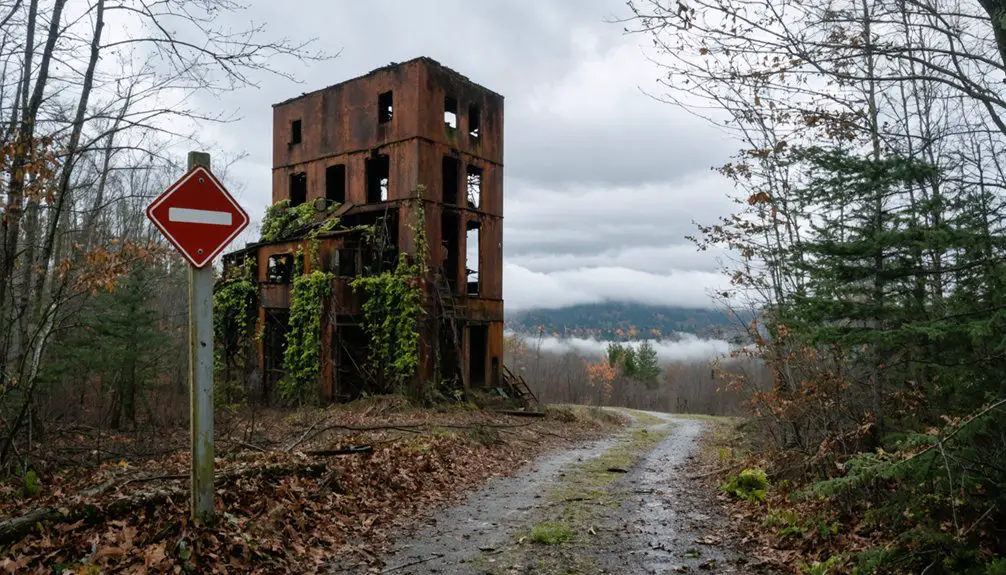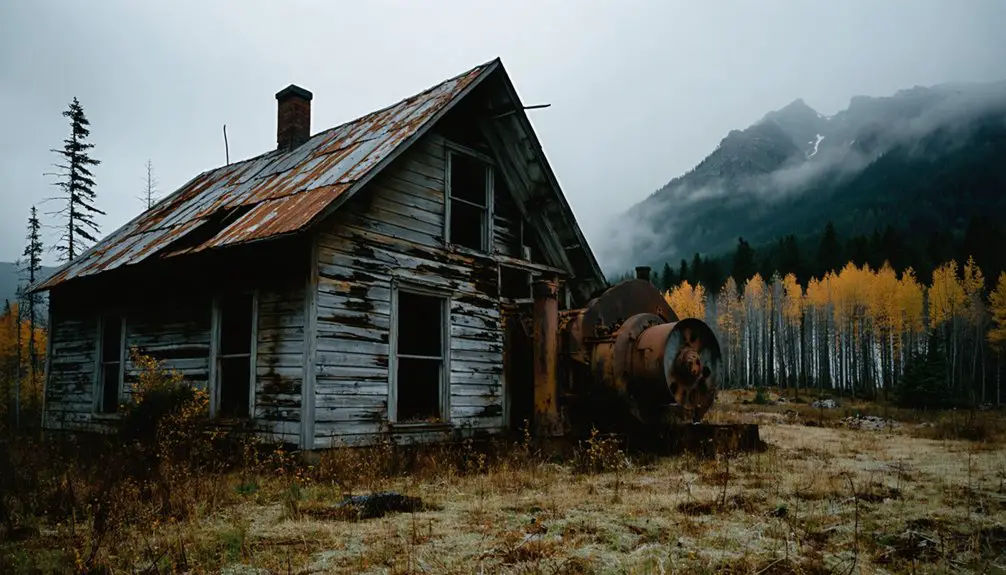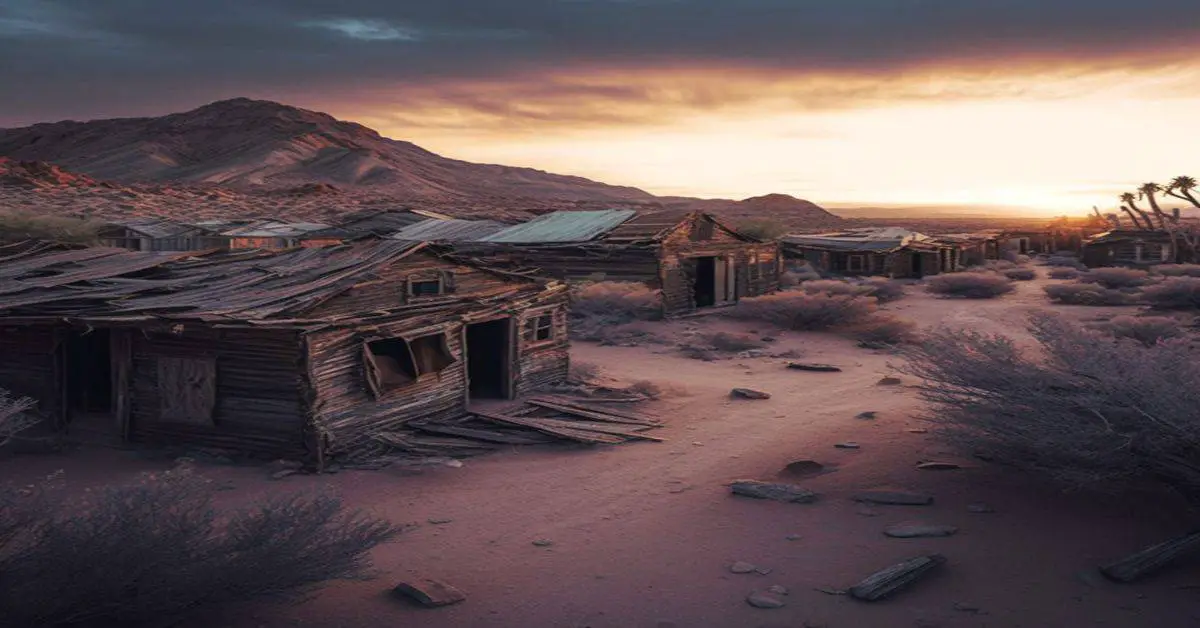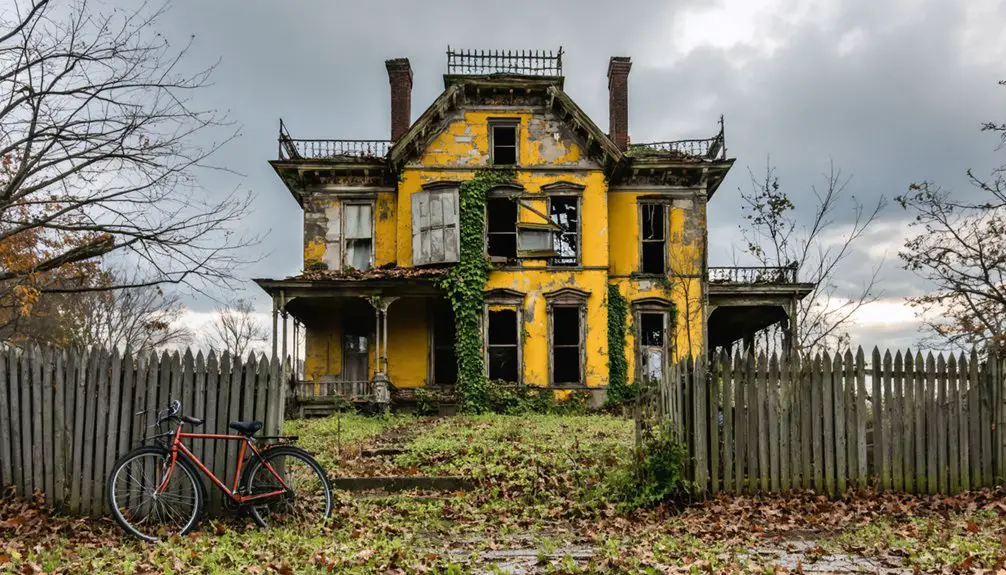You’ll find Tahawus, a historic mining village established in 1826, nestled deep in New York’s Adirondacks. Initially founded for iron ore extraction by Archibald McIntyre and David Henderson, it later boomed during the 1940s when National Lead Industries mined titanium dioxide, growing to 84 buildings and 400 workers. Today, only 10 structures remain, including MacNaughton Cottage and the 1854 blast furnace. The abandoned site’s rich history includes a pivotal moment in Theodore Roosevelt’s path to the presidency.
Key Takeaways
- Tahawus was established in 1826 as an iron mining village and later became a titanium mining town before closing operations in 1989.
- Only 10 of 84 original buildings remain today, including MacNaughton Cottage and the historic McIntyre Blast Furnace from 1854.
- The Open Space Institute preserves 212 acres of the historic core, protecting abandoned structures while maintaining public access through guided tours.
- Theodore Roosevelt’s midnight ride from Tahawus to North Creek station in 1901 marked a significant moment when he learned of McKinley’s death.
- Visitors report paranormal activity around abandoned mining facilities, including mysterious sounds, moving shadows, and unexplained lights near McNaughton Cottage.
The Rise of an Iron Mining Village
While many ghost towns emerged from failed gold rushes, Tahawus’s story began with iron ore in 1826, when prospectors Archibald McIntyre and David Henderson discovered deposits along the Upper Hudson River.
Initially named McIntyre, the bustling settlement quickly established a vibrant social dynamic with 16 dwellings, farms, and essential community structures. The village grew to include a blast furnace and other industrial facilities that supported the mining operations. The settlement made history by establishing the first bank in the Adirondack Mountains.
Mining Booms and Busts Through the Decades
After decades of dormancy following the original iron mining operations, Tahawus experienced a dramatic revival in 1940 when National Lead Industries discovered the site’s untapped potential.
Tahawus awakened from its mining slumber in 1940 as National Lead Industries unveiled new possibilities in the forgotten land.
The mining economy shifted from iron to titanium dioxide, driving wartime production and establishing a new workers’ settlement called Lower Works.
You’ll find that community resilience shaped Tahawus’s peak years, with 400 workers supporting a bustling industrial town that included 84 buildings by 1945. The federal government’s railroad made this expansion possible by solving transportation issues that had plagued earlier operations.
The operation extracted an impressive 40 million tons of titanium before its 1989 closure.
While the 1962 relocation to Newcomb marked the end of community life, the site’s legacy lives on through conservation. The company moved several buildings to the new location while abandoning others to deteriorate.
The Open Space Institute’s 2003 purchase of 10,000 acres preserved both the area’s natural beauty and historical significance, including the 1854 blast furnace.
Theodore Roosevelt’s Historic Connection
A pivotal chapter in American history unfolded at Tahawus Club in September 1901, when Vice President Theodore Roosevelt‘s vacation transformed into a dramatic ascent to the presidency.
After visiting the wounded President McKinley in Buffalo, you’ll find Roosevelt retreated to this remote Adirondack hunting club, where he soon climbed Mount Marcy. The treacherous ascent was made in cold drizzling rain. Initially, McKinley’s surgery appeared successful, leading officials to suggest Roosevelt depart.
As McKinley’s condition worsened, an urgent search ensued to locate Roosevelt on the mountain.
Roosevelt’s Legacy was sealed during his famous midnight ride to North Creek station – a perilous 35-mile journey over treacherous roads, switching horses at locations like Aiden Lair Lodge.
The Presidential Shift occurred during this very ride, as McKinley passed at 2:15 AM on September 14th, while Roosevelt pressed forward through darkness and mud to assume his new responsibilities.
Life in Tahawus During Peak Operations
During its peak operations in the mid-20th century, Tahawus transformed from a modest mining settlement into a bustling company town of 84 buildings that housed roughly 400 workers and their families.
You’d have found daily routines centered entirely around the mining operation, with workers heading to the titanium dioxide mines while their families maintained homes in the company-provided housing.
The town’s infrastructure included essential services like a garage and basic amenities, though you’d need to rely heavily on company supplies. The area was originally developed after the discovery of iron ore in 1826, marking the beginning of Tahawus’s mining heritage.
Community events and social activities revolved around the mining operations, with limited entertainment options beyond work life.
A government-built railroad connected you to the outside world, primarily serving to transport the strategic titanium ore that drove the town’s existence during the World War II era.
Abandoned Buildings and Remaining Structures
Time and neglect have greatly altered Tahawus’s landscape since its bustling mining days. Of the original 84 buildings that stood in 1945, you’ll now find only about 10 structures from that era still standing. The abandoned architecture tells a story of industrial decline, with most buildings removed for safety and environmental concerns.
Among the surviving remnants, you’ll discover the historically significant MacNaughton Cottage (1890-1930), where Theodore Roosevelt learned of his presidential destiny, and the imposing McIntyre Blast Furnace from 1854. The blast furnace was built to process iron ore containing titanium dioxide impurities, which ultimately led to the operation’s failure.
The Open Space Institute has preserved these landmarks within a 212-acre historic core, creating viewing platforms and trails for your exploration. While nature reclaims much of the former mining site, you can still spot industrial ruins, water-filled pits, and waste dunes that hint at Tahawus’s titanium mining legacy.
Local Legends and Haunted Tales
You’ll hear whispers of Tahawus’s most famous ghost, David Henderson, the former mining manager who died from an accidental gunshot wound and now reportedly rides horseback through the abandoned streets.
Night explorers frequently report unexplained sounds, shadowy figures, and an overwhelming sense of being watched while investigating the remnants of this once-bustling mining community.
The combination of tragic history, isolation, and deteriorating structures has earned Tahawus a reputation as one of the Adirondacks’ most haunted locations, drawing paranormal enthusiasts from across the region. The imposing MacIntyre Blast Furnace remains one of the few surviving structures, standing as a stark reminder of the town’s industrial past.
Ghostly Mining Manager Sightings
Among Tahawus’s most enduring supernatural tales, the ghostly mining manager sightings have captivated visitors since the town’s abandonment in 1962.
You’ll hear accounts of spectral sightings near the McIntyre Blast Furnace, where witnesses describe a figure in period attire – complete with dark suit, hat, and lantern – watching over his former domain. The ghostly figure is often seen near the $43,000 blast furnace that ultimately failed to improve the mining operation’s efficiency. These ghostly encounters often occur at dusk, particularly around the abandoned mine shafts and company offices.
The apparition’s presence manifests through sudden temperature drops, unexplained footsteps, and mysterious orbs in photographs.
You might catch glimpses of him near the railroad beds or waste dunes, where he’s said to maintain his eternal vigil. Local guides share tales of his watchful, sorrowful presence, suggesting a spirit forever bound to Tahawus’s rich mining history.
Tales From Night Explorers
When darkness falls over Tahawus’s crumbling remains, night explorers report a distinctly unsettling atmosphere that’s drawn paranormal investigators since the 1960s.
You’ll encounter unexplained phenomena around the 1854 blast furnace and scattered ruins, where visitors frequently describe being watched by unseen presences.
The night sounds you’ll hear aren’t typical forest noises – unexplained echoes reverberate through the abandoned mining facilities, while mysterious orbs and flickering lights dance near the McNaughton Cottage.
You’re likely to experience the most intense activity near the old residential ruins, where shadows move without source and vague apparitions materialize in the darkness.
The remote Adirondack setting amplifies these encounters, making Tahawus a magnetic destination for those seeking evidence of lingering spirits from the town’s complex past.
Conservation Efforts and Modern Tourism

You’ll find modern Tahawus’s trails carefully maintained by the Open Space Institute, which acquired 6,000 acres in 2003 to protect both visitors and historic structures.
The site’s remaining buildings, including the 1854 blast furnace and McNaughton Cottage where Theodore Roosevelt once stayed, are preserved but closed to public entry due to safety concerns.
Educational programs now focus on sharing the ghost town’s dual legacy as both an iron mining community and a presidential historical site, with interpretive signs guiding visitors through its significant locations.
Trail Access and Safety
Located at the base of Mount Marcy in the Adirondacks, Tahawus Ghost Town‘s trail access requires careful planning and safety considerations for modern visitors.
You’ll find the Upper Works Trailhead serving as your gateway, providing southern access into the High Peaks Wilderness with dedicated parking and interpretive trails.
For trail navigation, you can reach the site via the 14-mile round trip Tahawus Mines Road, though it’s gated near the ghost town. A hiking trailhead exists just before the second bridge.
Don’t rely on GPS or phone signals – they’re weak or nonexistent in this remote area. For visitor safety, avoid entering any remaining structures, as they’re unstable and potentially contaminated.
The MacNaughton Cottage and McIntyre Blast Furnace have been stabilized for safe viewing from designated areas.
Historical Structure Protection
The preservation of Tahawus’s historic structures began in earnest with the Open Space Institute’s acquisition of the 10,000-acre Tahawus Tract in 2004, marking a significant shift from abandonment to active conservation.
You’ll find the MacNaughton Cottage stands as a reflection of successful historical preservation efforts, while the iconic McIntyre Blast Furnace remains accessible through newly constructed viewing platforms.
OSI’s strategic approach prioritized safety and structural integrity by removing hazardous post-1940s buildings while protecting key historic remnants.
They’ve transferred most of the land to New York’s DEC but retained 212 vital acres for heritage protection.
The site’s listing on the National Register of Historic Places since 1977 has provided additional preservation guidelines, helping balance conservation needs with public access through maintained trails and modern infrastructure.
Educational Tourism Programs
Since acquiring the Tahawus tract in 2004, the Open Space Institute has developed extensive educational tourism programs that showcase the site’s rich mining heritage.
You’ll experience expert-led guided tours exploring the evolution from iron to titanium mining operations while learning about daily village life in this historic Adirondack community.
As you traverse accessible terrain, you’ll find interpretive signage that connects you to both the historical significance and ecological context of the region.
Your tour options include insights from NYS archaeologists and historians who bring the industrial archaeology to life.
While member fees are $50 and non-member fees are $60, your contribution directly supports preservation efforts and educational outreach, ensuring this remarkable piece of mining history remains accessible for future generations to explore.
Frequently Asked Questions
What Wildlife Can Visitors Commonly Encounter Around the Tahawus Ruins Today?
You’ll spot white-tailed deer, black bears, and coyotes during animal sightings, while bird watching reveals bald eagles, woodpeckers, and chickadees. Beavers, fish, and small mammals frequent the area.
Are There Guided Tours Available, and How Can Visitors Arrange Them?
You’ll find guided tour options through the Open Space Institute and Adirondack Archeological Conservancy. Book ahead by registering online – tours cost $50-60 and are led by expert historians and archeologists.
What Are the Best Seasons and Times to Photograph Tahawus?
You’ll capture the best shots in autumn, especially during golden hour when seasonal colors peak. Visit early morning for misty scenes or late afternoon when photography techniques benefit from warm, directional light.
Can Metal Detecting or Artifact Collecting Be Done at Tahawus?
You can’t legally metal detect or collect artifacts at Tahawus due to strict preservation regulations. The site’s protected status under DEC and Open Space Institute management prohibits removal of historical materials.
How Difficult Is the Hiking Terrain Around the Abandoned Town Site?
You’ll find easy hiking difficulty near the abandoned buildings, with flat terrain conditions and well-marked paths. While the ghost town area’s walkable, nearby mountain trails become considerably more challenging.
References
- https://secretnyc.co/tahawus-ghost-town-ny/
- https://en.wikipedia.org/wiki/Tahawus
- https://www.youtube.com/watch?v=xYXEkSdTLhc
- https://www.untappedcities.com/the-history-of-tahawus-once-a-thriving-mining-community-now-an-adirondack-ghost-town/
- https://www.onlyinyourstate.com/state-pride/new-york/tahawus-ny
- https://www.adirondackhub.com/story/2014/10/moving-village-tahawus
- https://www.adirondack.net/history/tahawus/
- https://www.adirondackexplorer.org/stories/digging-into-tahawus-mine
- https://www.adirondackhub.com/story/2018/tahawas-an-adirondack-mining-town
- https://www.newyorkalmanack.com/2022/08/teddy-roosevelts-wild-ride-to-the-presidency/



